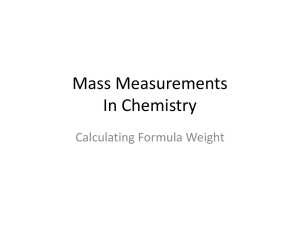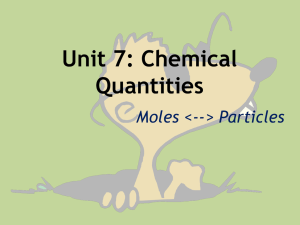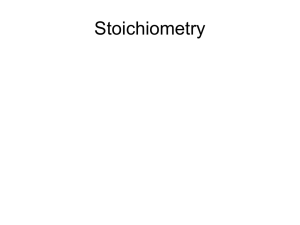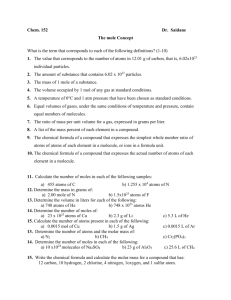EXPERIMENT 1 - Texas Digital Library
advertisement
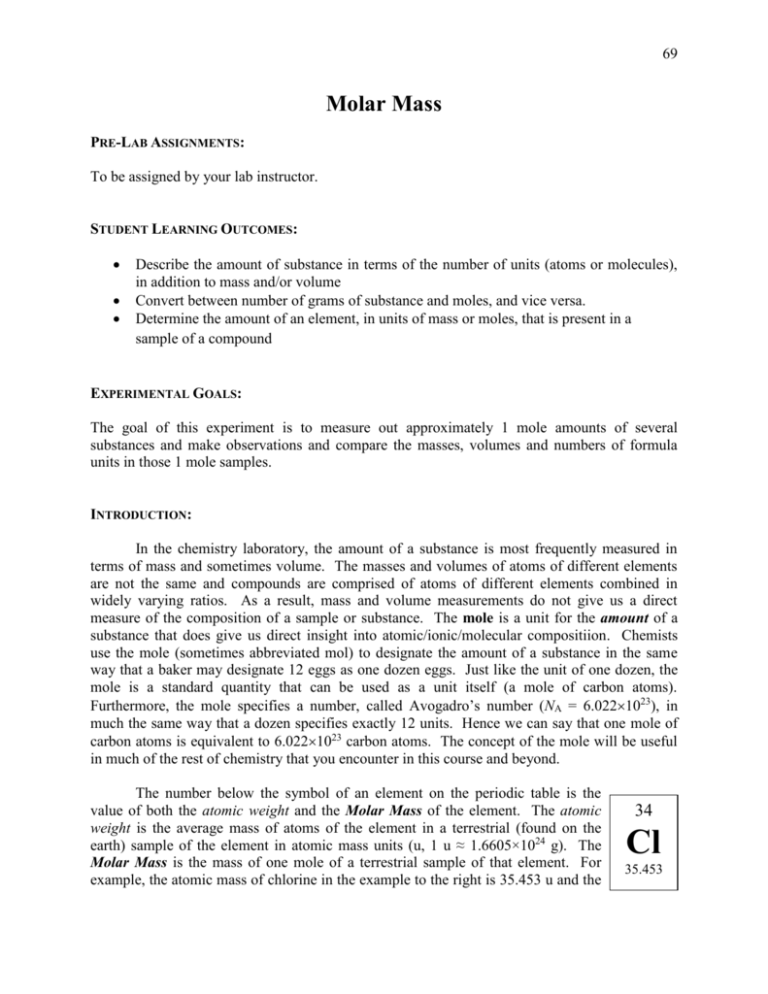
69 Molar Mass PRE-LAB ASSIGNMENTS: To be assigned by your lab instructor. STUDENT LEARNING OUTCOMES: Describe the amount of substance in terms of the number of units (atoms or molecules), in addition to mass and/or volume Convert between number of grams of substance and moles, and vice versa. Determine the amount of an element, in units of mass or moles, that is present in a sample of a compound EXPERIMENTAL GOALS: The goal of this experiment is to measure out approximately 1 mole amounts of several substances and make observations and compare the masses, volumes and numbers of formula units in those 1 mole samples. INTRODUCTION: In the chemistry laboratory, the amount of a substance is most frequently measured in terms of mass and sometimes volume. The masses and volumes of atoms of different elements are not the same and compounds are comprised of atoms of different elements combined in widely varying ratios. As a result, mass and volume measurements do not give us a direct measure of the composition of a sample or substance. The mole is a unit for the amount of a substance that does give us direct insight into atomic/ionic/molecular compositiion. Chemists use the mole (sometimes abbreviated mol) to designate the amount of a substance in the same way that a baker may designate 12 eggs as one dozen eggs. Just like the unit of one dozen, the mole is a standard quantity that can be used as a unit itself (a mole of carbon atoms). Furthermore, the mole specifies a number, called Avogadro’s number (NA = 6.0221023), in much the same way that a dozen specifies exactly 12 units. Hence we can say that one mole of carbon atoms is equivalent to 6.0221023 carbon atoms. The concept of the mole will be useful in much of the rest of chemistry that you encounter in this course and beyond. The number below the symbol of an element on the periodic table is the value of both the atomic weight and the Molar Mass of the element. The atomic weight is the average mass of atoms of the element in a terrestrial (found on the earth) sample of the element in atomic mass units (u, 1 u ≈ 1.6605×1024 g). The Molar Mass is the mass of one mole of a terrestrial sample of that element. For example, the atomic mass of chlorine in the example to the right is 35.453 u and the 34 Cl 35.453 70 molar mass is 35.453 g/mol. The two quantities, atomic weight and molar mass are numerically the same because both are defined in terms of the mass of carbon-12 atoms. This means that one mole of carbon atoms (≈6.022141023 chlorine atoms) has a mass of 35.453 g. Similarly, one mole of hydrogen atoms would have a mass of 1.00797 g, and a mole of iron atoms would have a mass of 55.847 g. The molar mass of a compound (sometimes referred to as the “molecular weight” for molecular compounds and the “formula weight” for ionic compounds) is obtained by adding up the molar masses of all of the elements in the compound multiplied by the number of atoms of each element in the compound. For example, the molar mass of ammonia, NH3, is obtained by adding the atomic mass of nitrogen and three times the molar mass of hydrogen: Molar mass of NH3 = 1 atomic mass of N + 3 atomic mass of H = 1 14.0067 g/mol + 3 1.00797 g/mol = 17.031 g/mol Definition of Formula Unit – In this lab, we will want to think about how many “units” of our compound are in a mole of the compound. Consider the phrase: ”one mole of water”. What does this mean? Since water is made up of water molecules, it seems reasonable that we have one mole (or Avogadro’s number) of water molecules. However, when we talk about an ionic compound, we cannot accurately say that 1 mole of magnesium chloride contains one mole of magnesium chloride molecules, because magnesium chloride is not made up of molecules, but of magnesium ions and chloride ions in a 1:2 ratio. To clarify this we can refer to a formula unit of a compound. A Formula Unit is the smallest collection of atoms that can have all of the properties of a compound and is represented by that compounds formula. When we talk about having a mole of a substance, we mean that we have one mole of formula units of that substance in the sample. Just like a dozen bicycles might be made up of 2 dozen wheels and one dozen frames, a mole of formula units can have different numbers of moles of the atoms or ions that make up the compound. For example, a mole of water molecules contains two moles of hydrogen atoms and one mole of oxygen atoms. Similarly, sodium sulfate (Na2SO4) contains two moles of Na+ ions and one mole of SO42- ions; it also contains 4 moles of oxygen atoms. The mole is one of the most useful concepts in chemistry due to the fact that ratios betweens chemical entities in a compound or chemical species is exactly matched by the mole ratio of those species. The mole provides us with a way of measuring macroscopic amounts of elements, ions or compounds and relating that information to chemical formulas and equations. The mole provides us with a method of relating macroscopic measurements to what is occurring at the atomic/molecular level! PRELAB ASSIGNMENT: Look up (elements) or calculate (compounds) the mass of one mole of each of the substances listed in the data table. Show your work and report your results clearly on a piece of 8.5”×11” notebook paper to be turned in at the start of lab. Enter these values in the Target Mass column of Data Table 2. 71 PROCEDURE: A. General Directions and Setup Students will work in pairs and each pair will measure out approximately (± 0.1 g) one mole of one of the substances. The sample will be placed in a graduated cylinder of an appropriate size to estimate the volume of a sample to at least two significant figures. A label should be placed on that cylinder that gives the name and formula of the substance and the actual mass of the sample. The samples thus prepared will be placed in one location in the lab and each student will use this display to complete Data Table A. Your instructor will assign each pair of students a substance or will guide you in the choosing a substance. B. Obtaining and comparing ~1 mole of substance Most balances in our lab have a 120 or 150 gram capacity. A 100 mL beaker weighs ca. 44 g. If the weight of your sample and the beaker taken together is grater than 120 g, you will have to use a special balance located in one of the labs to weigh your sample: consult your instructor for further directions. For sucrose, use a 400 mL beaker for weighing. Use a 250 mL beaker for benzoic acid, methyl salicilate, magnesium nitrate hexahydrate and methyl salicylate. Use a 100 mL beaker for all other substances. High accuracy and precision are not required for this lab. Therefore we will use the “tare” function of the balances to speed the weighing of samples. To use the tare function, place the beaker on the balance and push the tare or zero method. The scale should read 0.000 g (or 0.00 g on the high capacity scale). Add substance to the beaker until you get a mass that is within 0.2 g (within 1 g if your sample will be greater than 100 g) of the molar mass. Record the mass of the sample directly from the scale to as many significant digits as the balance permits. (It is possible that the scale zero has drifted since the balance was “tared” (zeroed) so that this mass may be slightly off. This will not affect the results in this lab, but the tare method is not recommended when accuracy is required.) Use the volume level in the beaker to estimate a graduated cylinder size to transfer your sample into. We will use the graduated cylinder to approximate the volume of the sample to at least 2 significant digits. Transfer the sample to the graduated cylinder and record the volume. For solids, do not try to estimate the volume to 1/10 of the smallest division. Record this volume in your data sheet. Use the mass of your sample to calculate the actual number of moles of substance you measured and the number of formula units in your sample. You and your partner(s) 72 should do the calculations independently and then compare your results. On a piece of labeling tape record the following information: Name of sample Grams of sample Approx. volume of sample Moles of sample Number of formula units of sample Also record this information on the class summary sheet. Place the label on you cylinder and then place you cylinder on the designated table or counter so that the sample can be available for other students to compare. C. One Mole of Gas Examine the volume of a mole of gas. Note that a mole of any gas will have this volume under identical pressure and temperature conditions. 73 Molar Mass Data Table Goes Here 74 D. Data Analysis Compare the one mole samples and answer the following questions. 1. In general, will one mole of a substance have the same mass as a mole of a different substance? Why is this so? 2. In general, do one mole quantities of different substances have the same volume? Why do you think this is so? 3. The apparent volume of you sample was not always the same for one mole of some of the samples looked at in the study. What caused the variation? Under what conditions would it be reasonable to use volume to measure the amount of a substance? Under what conditions should you be cautious using volume for that purpose? 4. What did all one mole property did all one mole quantities have in common? 5. For gasses, one mole of almost any gas will have the same volume under the conditions of temperature and pressure. Think about the behavior of the species (molecules, atoms or ions) that make up solid, liquid and gas samples and try to explain why one mole of different gasses may have the same volume, but molar quantities of solids and liquids rarely have the same volume. 75 E. Study Problems. Use the information in Part C to answer the following questions. 1. Determine the amount of each of the following entities there are in 1 molecule of SiO2: _______ total atoms _______ O atoms _______ Si atoms 2. Determine the amount of each of the following entities that are in 1 dozen water molecule? _______ total atoms _______ O atoms _______ H atoms _______ dozens of atoms _______ dozens of O atoms _______ dozens of H atoms 3. Determine the amount of each of the following entities that are in 1.5 dozen sugar molecules? _______ dozens of total atoms _______ dozens of H atoms _______ C atoms _______ O atoms F. Questions. For the questions below, report your answers to the correct number of significant figures. 1. How many moles of oxygen atoms were in your group’s sample of SiO2? ____________________ 2. How many O atoms is that equivalent to? ____________________ 3. How many grams of O atoms would that be? ____________________ 4. How many moles of carbon were in your group’s sample of sucrose? ____________________ 5. How many moles of hydrogen were in your group’s sample of water? ____________________ 6. How many atoms of oxygen were in your group’s sample of sugar? ____________________ 7. The ASU Porter-Henderson library has about 1.5 million items (books, journals, manuscripts, et cetera) in its collection. What fraction of a mole of library items does this represent? If 1.5 million items occupy 3 stories in our library, how many stories would be necessary to have a mole of library items?
